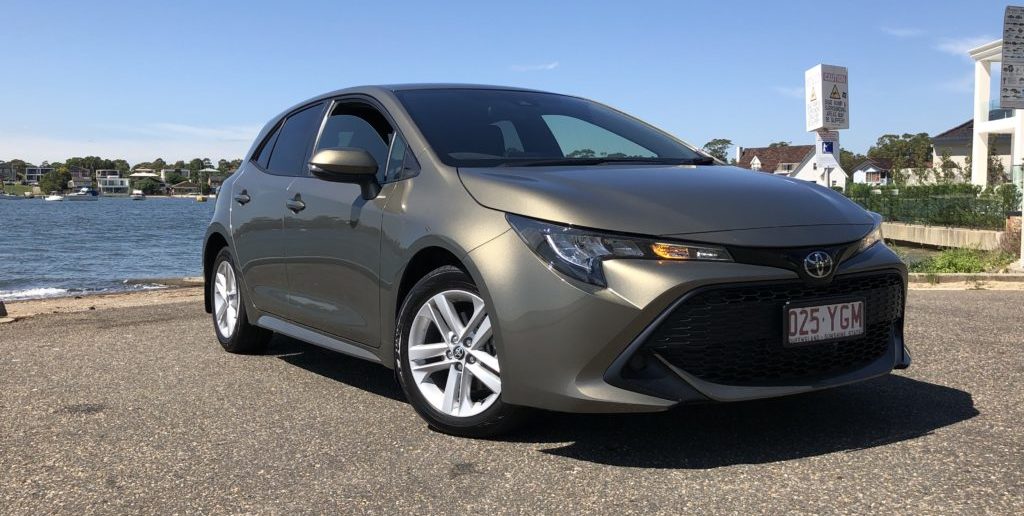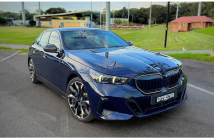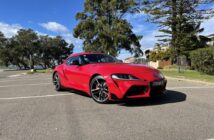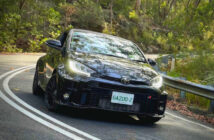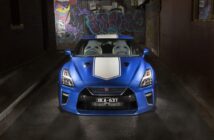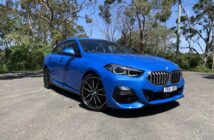Our Rating
The new Corolla Ascent Sport gets a brand new design and engine, making it an incredibly capable car. It has a wide range of added features, new safety technology and cabin, but lacks CarPlay and definitely requires more boot space. The added power from the new engine is instantly noticeable and the ride is incredibly comfortable.
-
Engine & Drivetrain
-
Performance
-
Fuel Economy
-
Interior
-
Gadgets & Technology
-
Safety
-
Ride & Comfort
-
Practicality
-
Affordability
-
Behind the Wheel
Engine
The 2019 Corolla gets a fresh new range of engines, beginning with the base petrol engine (as tested) with an upgraded 2.0-litre engine. This new engine puts out 125kW of power at 6600rpm and 200Nm of torque at 4400rpm.
This is a huge upgrade from the previous generation Corolla which had only 103kW of power and 173Nm of torque. We were significantly impressed with the power jump in the new Corolla and could tell instantly that it had been boosted over the previous generation.
Our tester had the automatic gearbox. Commendably, the automatic that most people will opt for only costs $1500 more. Props to Toyota for making the auto option fairly affordable. It is a CVT (constantly variable transmission), but has a novel torque converter on the dedicated launch gear, meaning take-offs are sharper. There’s also a 10-gear manual mode controlled by paddles. It means that motorway cruising is super seamless with insanely low revving figures when at 100kmh+.
The engine handles itself well and can pull when it needs to. It has enough juice to overtake effortlessly, particularly as you notably hear the engine pushing itself to its limits. It does however lack the extra torque of turbocharged competitors – perhaps something for Toyota to look into in the future.
Overall, we found ourselves incredibly impressed with the new engine. We will also be testing the hybrid model in the near future and will compare the likes of both engines to each other. But the new 2.0-litre petrol engine is great, with many improvements – we just hope the CVT’s are reliable.
Performance
While it lacks the extra push that a turbo rival would boast, the engine is incredibly smooth, and powers through the gears effortlessly.
The new Corolla will take 8.5 seconds to go from 0-100km/h, which is fairly impressive considering the previous generations could barely do it in 10-11 seconds. Again, the power and torque improvements on this model are fantastic.
Given the lack of turbo, the new Corolla won’t get any torque steer as there isn’t enough to make it worry. It handles itself sharply around corners for an entry level hatchback.
The front suspension has: MacPherson strut, coil spring, gas damper, anti roll bar, whilst the rear suspension has: torsion bar, coil spring, gas damper.
Around some windy roads, the Corolla Ascent Sport can grip itself without an abundance of understeer. Of course you will get some understeer and skidding from a front wheel, entry level hatch, but this Corolla holds itself together surprisingly well.
The dense profile tires give the car extra grip as it lays a thick chunk of rubber on the tarmac to keep it planted – but this also means it is an incredibly comfortable ride.
Overall, the car performs surprisingly well for an entry level hatchback. Mazda 3, Kia Cerato and the Hyundai i30 should watch out for the new Corolla as it takes a seriously big leap for the Corolla.
Fuel Economy
Toyota claims combined-cycle fuel use of 6.0L/100km, with the tank measuring 50L to the maximum. Going off this figure is remarkable for a non hybrid, non turbo 2.0-litre vehicle.
Better yet, the engine can run on 91RON fuel which is the cheapest to run and the car will have no dramas doing so.
In our testing, we compared the difference between using 91RON, Premium 95 and Premium 98 fuel. These were all filled up from the exact same service station to ensure consistency.
After filling up with 91, the car felt exactly as it was when we had first gotten it, and we managed to average about 7.0L/100km on the combined cycle, with a fair bit more motorway driving. We were able to get the car to about 600-650km before the fuel light came on.
Once filled up with 95 and 98 several times, there was a slight, but barely noticeable increase in performance – it just felt that ever bit so slightly smoother. But not enough to justify an extra 20% in fuel costs, especially when the car takes 91RON with no dramas at all. Filling up with 95 and 98 returned around 6.5-7.0L/100km, which meant an extra 50km or so before the light came on, so 650-700km.
It must be noted that in pure urban driving, the economy drops to around 8-10L/100km (as expected), with a range of about 4-500km per tank in the city.
Impressive fuel consumption figures for a car with no gimmicks or fancy technology, just a straight petrol engine that gets the job done.
Interior & Technology
The steering wheel feels quite sharp, and the integration of its cruise control and audio buttons is fairly intuitive. The instruments are simple, and the digital trip computer off to the side gives you the long-needed digital speedometer.
A few minor things that I am nit-picking however is the digital speedo/trip computer should be in the middle as opposed to the side, and the next/previous track buttons should be on the same side as the volume up/down buttons, instead of sitting below the cruise control bottoms.
The seats are trimmed in cloth but offer a decent amount of adjustment, and are distinctly more comfortable and supportive. These seats have a slight bucket fell and mould you in very well. Also, the fascia layout is modern with a mounted tablet screen above a digital AC readout, all operated by sleek buttons and knobs.
Materials inside the vehicle include soft plastic and cloth on key touchpoints, to the glossy black contrast panels. There are also well thought out storage areas such as the phone cubby below the fascia. Although that would be the perfect spot for a Qi Wireless Charger that the higher end models receive. And as Toyota is yet to integrate CarPlay/Android Auto, that spot for your phone is useless as your phone will likely be mounted in a dock.
The infotainment system is not impressive in any way. As aforementioned, it lacks CarPlay/Android Auto. Sat nav is not standard. And it even lacks a capacitative touch screen. Although, the Bluetooth is incredibly quick and reconnects almost instantaneously when hopping back in the car.
Another concern for almost anybody buying this car: the air vents! The air conditioning part of them is fine, but the fact that they sit sunken in just makes things so much worse for phone users. If this car had CarPlay/Android Auto, sure this wouldn’t concern me as I could just plug my phone in via USB, then leave it in the phone cubby below, easy done.. But, phone users would want to mount their phones to use apps like Google Maps, Apple Maps, Waze, Spotify, answer calls etc, which means utilising a phone dock holder, but none fit thanks to the sunken air vents! We tried multiple and only 1 ‘just’ fit, magnetic holders = no chance, nor is there any space to attach one on with a sticky holder.
The seat for the driver and passenger is fairly decent, but if you are a reasonably tall person that needs leg space up front, you will inevitably push your chair a bit back, which can make it quite cramped for the rear passengers.
Further, the boot space is tiny. Sure it comes with a full size spare wheel (amazing), but it’s almost as if the spare wheel isn’t lowered into the base of the car, instead it takes up half of the space of what would be the normal boot.
The interior has been done well, but has some setbacks that require some attention for future models.
Safety
Without dispute however, Toyota has not cut corners on safety and protection. Beyond the full suite of airbags and five-star ANCAP crash rating, the Ascent Sport also gets a long list of technologies that fall under the Toyota Safety Sense bracket.
These include:
– autonomous emergency braking (AEB) that works at all legal speeds
– adaptive cruise control
– road-sign assist
– lane-departure alert
– lane-trace assist system that helps physically keep the car in the lane if your mind wanders
The AEB started beeping at reasonable speeds before approaching slowing down cars, and the system did well to point out cars slowing down.
Adaptive cruise control was great. Utilising the same radar, it would speed up and slow down with ease. However, when going down a hill, the Corolla did not slow itself down well at all (in cruise control). In fact, it would keep going till about 10kmh+ over what you set it to cruise to and just beep and beep. Competitor systems do a much better job at braking cars down hills.
The lane departure alert is incredibly support, and beeps like crazy when you drift out of your lane. The lane-trace assist holds the car in its lane for up to around 5 seconds before it beeps and deactivates itself. Hyundai’s can hold in the lane for up to around 20 seconds, but perhaps this is worse? The Toyota system is just for that extra bit of safety, which I like as we should not depend on these systems – they are there as an aid.
Ride & Comfort
The Ascent Sport rides well for an entry level hatch. Obviously, it lacks that extra bit of power that a turbo would have, but the car has been radically improves from older generations.
The interior could be more inviting, however the car itself drives incredibly well and these little issues I have are simply me being nit-picky (but that’s my job).
It holds itself together around bends surprisingly well and is incredibly comfort to ride in. I found myself not worrying about potholes as the car just glided over them with ease.
A fairly comfortable ride with many major improvements that we were impressed with.
Warranty & Servicing
Toyota allows for longer servicing intervals of 12 months or 15,000km, with the first handful of visits capped to just $175 each.
That goes a long way to offsetting the sub-par warranty term of three years/100,000km.
Pricing
Ascent Sport 2.0LULPCVT AUTO $24,370
Ascent Sport 2.0LULP6 SP MAN $22,870
ASCENT SPORT (HYBRID) 1.8LULPCVT AUTO $25,870
SX 2.0LULPCVT AUTO $26,870
SX (HYBRID) 1.8LULPCVT AUTO $28,370
ZR 2.0LULPCVT AUTO $30,370
ZR (HYBRID) 1.8LULPCVT AUTO $31,870
Overall
The Corolla Ascent Sport is an incredibly predictable car but in the best way possible. Fuel is cheap, services are affordable, it has minimal known issues, comfortable to ride in, has plenty of technology and doesn’t cost an arm and a leg.
We are impressed with the 2.0-litre petrol engine and the extra power that it puts out, however, the car does need some improvements in terms of the technology, interior and boot space.
It handles itself well and provides a great option as an entry level hatchback that will get the job done and not be a hassle in the process.
ALL our videos of the Corolla Ascent Sport Petrol:
Full Exterior & Interior Tour:
Exhaust Sound:
Tech Review:
Engine Tour:
POV Test Drive:

